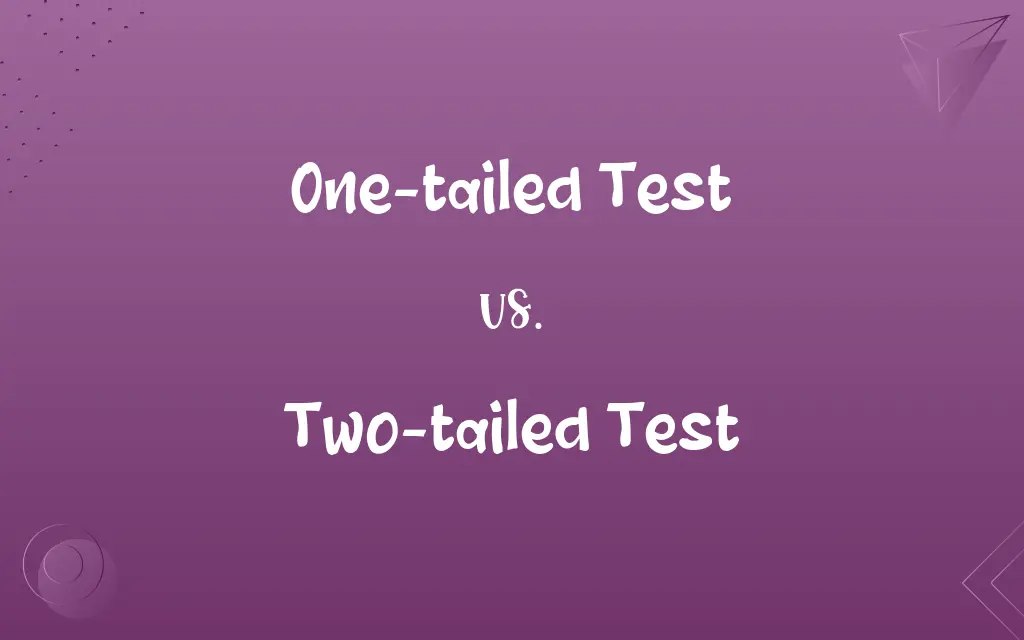One-tailed Test vs. Two-tailed Test: Know the Difference

By Shumaila Saeed || Published on January 19, 2024
One-tailed test predicts a direction in results (higher or lower), while two-tailed test checks for any significant difference, irrespective of direction.

Key Differences
A One-tailed Test focuses on determining if there is a statistically significant difference in a specific direction (greater or lesser). In contrast, a Two-tailed Test evaluates if there's any significant difference in either direction, without a specific prediction.
Shumaila Saeed
Jan 19, 2024
The One-tailed Test is used when a hypothesis predicts a direction of the outcome. Conversely, the Two-tailed Test is applicable when the research does not predict the direction, instead just questioning the existence of a difference.
Shumaila Saeed
Jan 19, 2024
Sensitivity is higher in a One-tailed Test for detecting effects in one direction, as it concentrates statistical power in that direction. On the other hand, a Two-tailed Test splits the statistical power for both directions, being less sensitive but more comprehensive.
Shumaila Saeed
Jan 19, 2024
In a One-tailed Test, the significance level is all set in one tail of the distribution, making it more prone to type I errors if the prediction is wrong. The Two-tailed Test divides this level between both tails, reducing the risk of such errors when direction is not certain.
Shumaila Saeed
Jan 19, 2024
Researchers use the One-tailed Test when they have a strong theoretical foundation to expect a directional result. In contrast, the Two-tailed Test is preferable in exploratory or initial research where the direction of the effect is not anticipated.
Shumaila Saeed
Jan 19, 2024
ADVERTISEMENT
Comparison Chart
Direction of Hypothesis
Predicts a specific direction
Does not predict direction
Shumaila Saeed
Jan 19, 2024
Sensitivity
More sensitive to effects in one direction
Less sensitive, but covers both directions
Shumaila Saeed
Jan 19, 2024
Risk of Errors
Higher risk of Type I error if wrong direction is predicted
Lower risk as it covers both directions
Shumaila Saeed
Jan 19, 2024
Application
Used with strong theoretical backing for direction
Used in exploratory research without directional hypothesis
Shumaila Saeed
Jan 19, 2024
Significance Level Allocation
Entirely in one tail of the distribution
Divided between both tails of the distribution
Shumaila Saeed
Jan 19, 2024
ADVERTISEMENT
One-tailed Test and Two-tailed Test Definitions
One-tailed Test
More powerful for detecting effects in a predicted direction.
A one-tailed test revealed a significant increase in sales post-advertisement.
Shumaila Saeed
Jan 05, 2024
Two-tailed Test
Tests both sides of the mean in a distribution.
A two-tailed test determined if the medication altered heart rate either way.
Shumaila Saeed
Jan 05, 2024
One-tailed Test
Focuses on one side of the mean in a distribution.
To check if the average weight is less than 150 lbs, a one-tailed test is applied.
Shumaila Saeed
Jan 05, 2024
Two-tailed Test
Equally sensitive to effects in both directions.
A two-tailed test showed significant change in customer satisfaction, both increase and decrease.
Shumaila Saeed
Jan 05, 2024
One-tailed Test
Assumes no significant effect in the non-predicted direction.
The one-tailed test ignored the possibility of decreased performance post-training.
Shumaila Saeed
Jan 05, 2024
ADVERTISEMENT
Two-tailed Test
Allocates significance level across both tails of distribution.
The two-tailed test revealed an unexpected direction in the treatment’s effect.
Shumaila Saeed
Jan 05, 2024
One-tailed Test
Used when the hypothesis has a directional prediction.
To determine if a training program improves scores, a one-tailed test was conducted.
Shumaila Saeed
Jan 05, 2024
Two-tailed Test
Assesses for any significant difference, regardless of direction.
To see if a diet affects weight, a two-tailed test was used.
Shumaila Saeed
Jan 05, 2024
One-tailed Test
A statistical test predicting a direction of difference.
In testing if a new drug increases recovery rate, a one-tailed test is used.
Shumaila Saeed
Jan 05, 2024
Two-tailed Test
Applicable when hypothesis does not specify a direction.
Investigating if a new teaching method impacts grades, a two-tailed test was chosen.
Shumaila Saeed
Jan 05, 2024
Repeatedly Asked Queries
When is a One-tailed Test used?
When the hypothesis has a directional prediction.
Shumaila Saeed
Jan 19, 2024
Can a One-tailed Test detect effects in non-predicted directions?
No, it only focuses on the predicted direction.
Shumaila Saeed
Jan 19, 2024
Is a One-tailed Test more sensitive than a Two-tailed Test?
Yes, but only in the predicted direction.
Shumaila Saeed
Jan 19, 2024
What are the risks of a One-tailed Test?
Higher risk of Type I error if the predicted direction is incorrect.
Shumaila Saeed
Jan 19, 2024
What is a One-tailed Test?
It's a statistical test predicting outcome in a specific direction.
Shumaila Saeed
Jan 19, 2024
What is a Two-tailed Test?
A test assessing for any significant difference, regardless of direction.
Shumaila Saeed
Jan 19, 2024
Can a Two-tailed Test detect effects in both directions?
Yes, it's equally sensitive to effects in both directions.
Shumaila Saeed
Jan 19, 2024
Is a Two-tailed Test less powerful than a One-tailed Test?
Yes, in terms of sensitivity in a specific direction.
Shumaila Saeed
Jan 19, 2024
Can a One-tailed Test miss significant effects?
Yes, if effects occur in the non-predicted direction.
Shumaila Saeed
Jan 19, 2024
Can a One-tailed Test become a Two-tailed Test?
Not directly; the test type should align with the hypothesis.
Shumaila Saeed
Jan 19, 2024
Which test has a higher chance of detecting unexpected results?
Two-tailed Test, as it checks both directions.
Shumaila Saeed
Jan 19, 2024
Are One-tailed Tests suitable for testing non-specific hypotheses?
No, they are designed for specific, directional hypotheses.
Shumaila Saeed
Jan 19, 2024
Why choose a Two-tailed Test?
When the hypothesis does not specify a direction.
Shumaila Saeed
Jan 19, 2024
Is a Two-tailed Test more conservative than a One-tailed Test?
Yes, as it considers both directions equally.
Shumaila Saeed
Jan 19, 2024
What type of error is more common in One-tailed Tests?
Type I error, due to the prediction of a specific direction.
Shumaila Saeed
Jan 19, 2024
Are Two-tailed Tests common in exploratory research?
Yes, due to their non-directional nature.
Shumaila Saeed
Jan 19, 2024
Can a Two-tailed Test be used for directional hypotheses?
It can, but it's less efficient than a One-tailed Test for this purpose.
Shumaila Saeed
Jan 19, 2024
Should a beginner researcher use a Two-tailed Test?
Yes, it's a safer choice when unsure about the direction of the effect.
Shumaila Saeed
Jan 19, 2024
How does a Two-tailed Test allocate significance level?
It's divided between both tails of the distribution.
Shumaila Saeed
Jan 19, 2024
Do Two-tailed Tests require more data than One-tailed Tests?
No, data requirements depend on the study, not the test type.
Shumaila Saeed
Jan 19, 2024
Share this page
Link for your blog / website
HTML
Link to share via messenger
About Author
Written by
Shumaila SaeedShumaila Saeed, an expert content creator with 6 years of experience, specializes in distilling complex topics into easily digestible comparisons, shining a light on the nuances that both inform and educate readers with clarity and accuracy.









































































